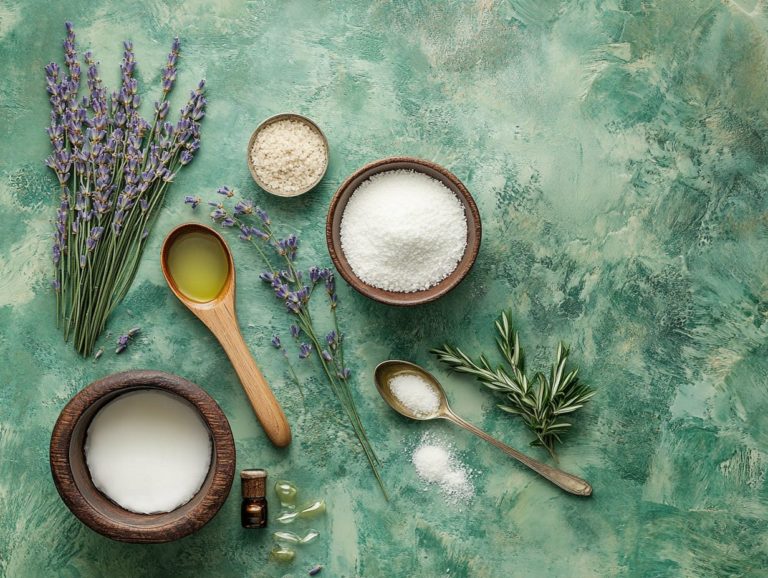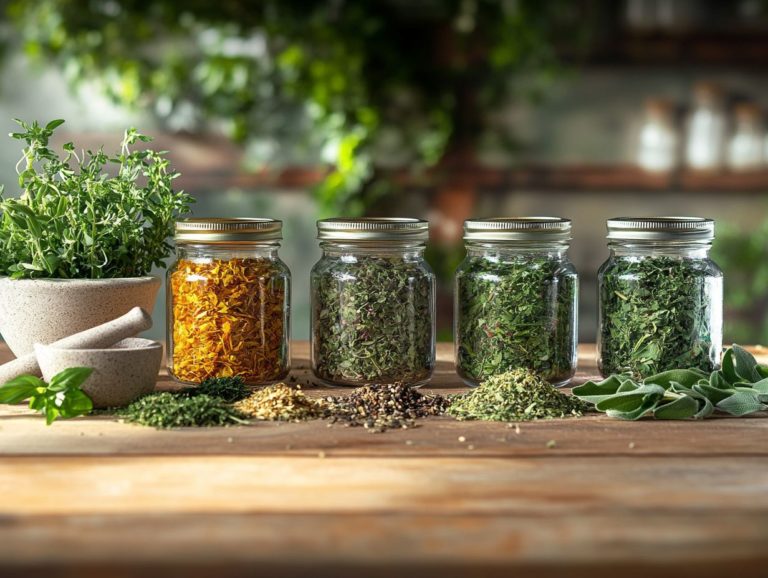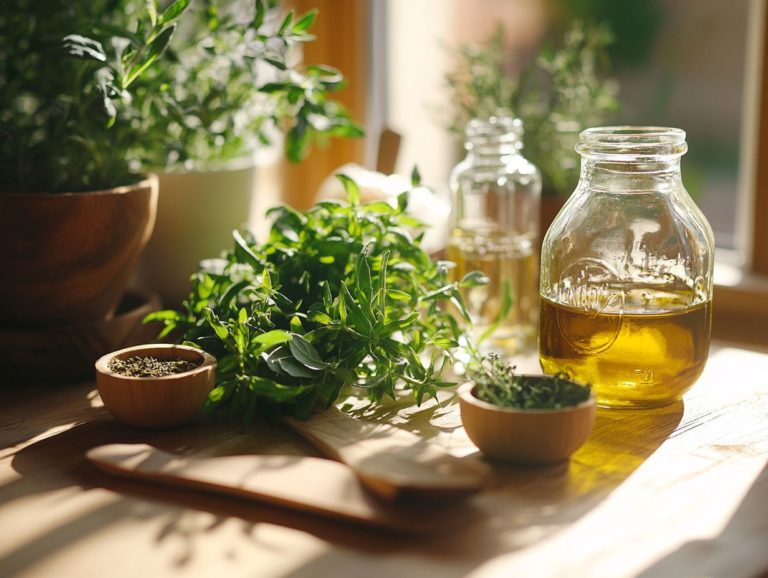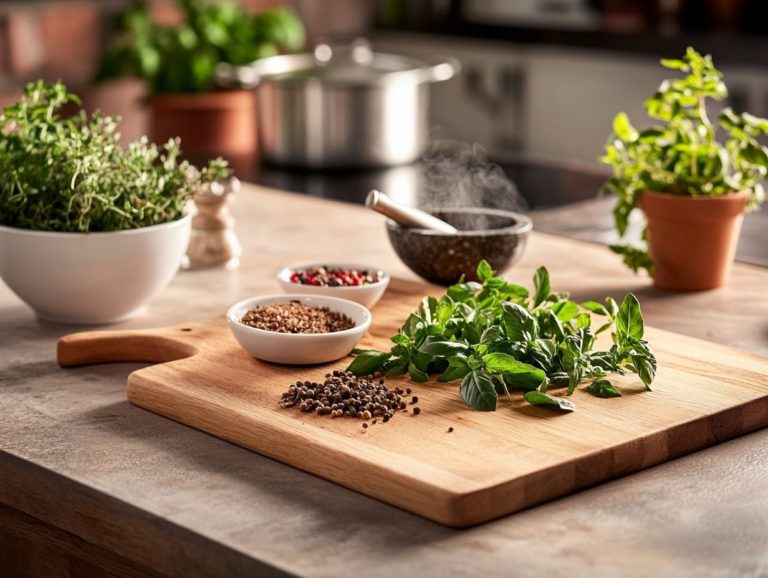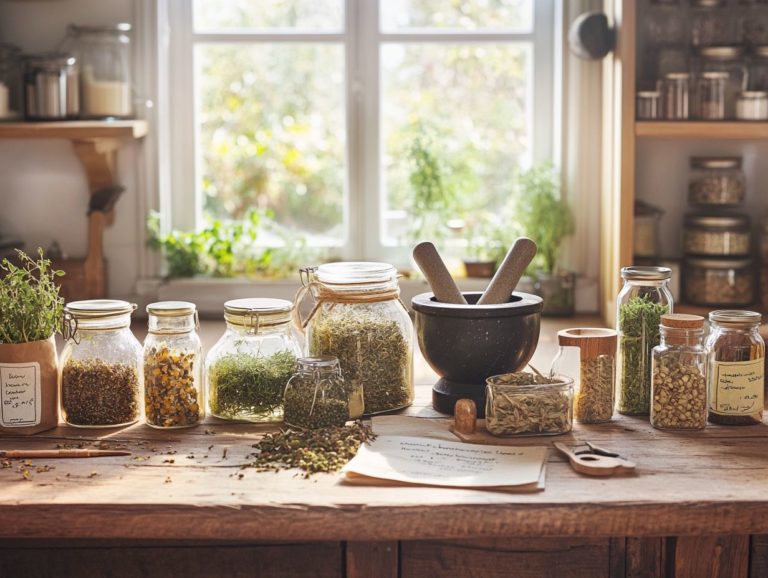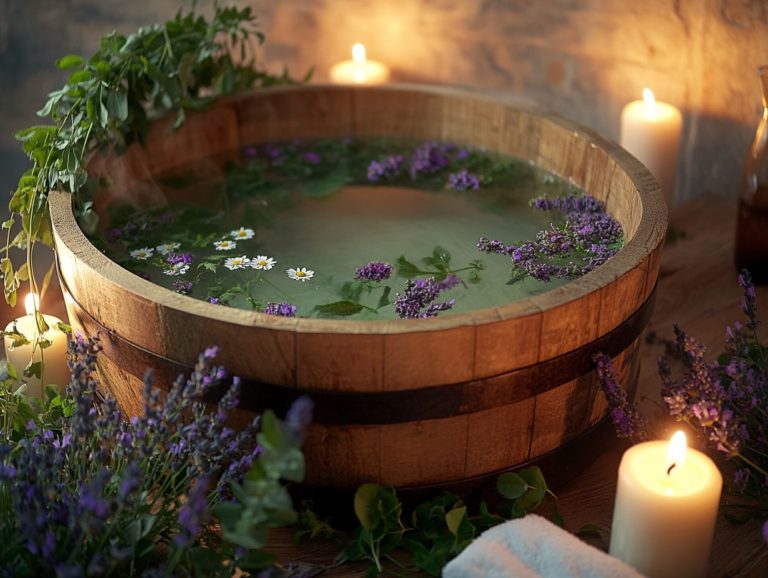Homemade Herbal Salves: A Quick Guide
Herbal salves beautifully combine nature s healing properties with practical wellness solutions, making them a sought-after choice among many herbal remedies.
These versatile balms can alleviate a range of ailments, presenting a natural alternative to chemical-laden products typically found on store shelves. They offer effective solutions for dry skin and minor cuts.
This guide explores the essence of herbal salves, highlighting their numerous benefits and providing insights on creating your own homemade salve.
As you discover common herbs and their uses, such as calendula and St. John’s wort, along with essential storage tips for your herbal oil, you’ll be well-equipped to harness the power of these remedies for everyday needs.
Contents
- Key Takeaways:
- The Basics of Herbal Salves
- Benefits of Using Herbal Salves
- Summary
- How to Make Your Own Herbal Salves
- Common Herbs Used in Salves
- Tips for Storing and Using Herbal Salves
- Frequently Asked Questions
- What are homemade herbal salves?
- What are the benefits of using homemade herbal salves?
- What ingredients are commonly used in homemade herbal salves?
- Is it hard to make homemade herbal salves?
- Are homemade herbal salves safe to use on all skin types, including sensitive skin?
- What are some common uses for homemade herbal salves and DIY remedies?
Key Takeaways:
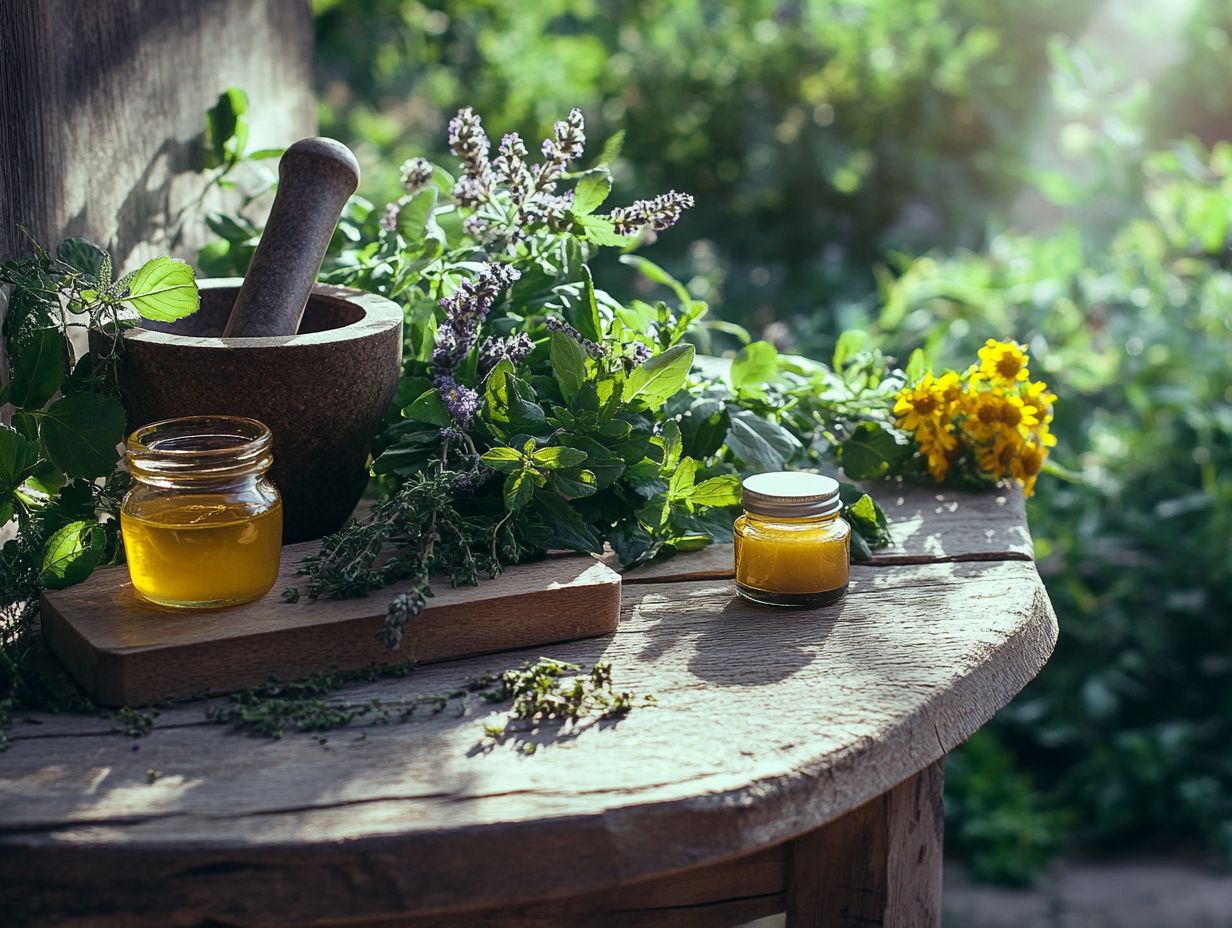
- Homemade herbal salves are natural remedies made from herbs and oils, providing numerous healing benefits for the skin and body.
- Using herbal salves can be more effective and cost-efficient than store-bought products, as they harness the healing properties of specific herbs for targeted results.
- Making your own herbal salves is simple and customizable, using a straightforward process and common herbs like lavender flowers, chamomile, and lemon balm. Proper storage and usage can ensure maximum effectiveness.
The Basics of Herbal Salves
Herbal salves are exquisite topical treatments crafted from natural ingredients, such as infused oil and beeswax. They harness the remarkable healing properties of plants known for their healing benefits, designed to nourish the skin and address a variety of ailments. These age-old remedies have been used for centuries in herbal medicine, providing soothing relief for issues like dry skin, minor cuts, bruises, and even eczema.
By grasping the fundamentals of herbal salves, you can embark on the journey of creating your own personalized salve, tailored specifically to your needs, guided by the wisdom of an experienced herbalist.
What are Herbal Salves?
Herbal salves serve as concentrated topical treatments that tap into the remarkable healing properties of medicinal plants. They present a natural alternative to synthetic products.
These salves usually contain infused oils made by steeping herbs in carrier oils like coconut or olive oil to draw out their beneficial qualities. For those interested in a more hands-on approach, learning how to create herbal skin treatments at home can be a rewarding process. Essential oils are also crucial, offering delightful fragrances along with therapeutic benefits, including antibacterial and anti-inflammatory effects.
The value of herbalist knowledge is vital for creating effective salves, especially in understanding how to create herbal tinctures easily using herbs like calendula, comfrey, and yarrow in your formulations. By recognizing the properties of each ingredient, you can select the perfect blend for specific concerns. This expertise enables you to create salves that are not just potent but also customized to meet the unique needs of individuals seeking natural remedies.
Benefits of Using Herbal Salves
The advantages of using herbal salves extend beyond simple topical applications. They provide an array of healing properties derived from the powerful medicinal herbs included in their formulation, such as arnica and dandelion.
Healing Properties of Herbs
The healing properties of herbs are essential to the effectiveness of herbal salves. Each medicinal herb offers its own unique benefits and soothing qualities.
Take calendula, for example; it’s celebrated for its anti-inflammatory effects, making it a fantastic ally for soothing minor burns and cuts, especially when combined with herbal oils in your salve recipe. For those interested in more techniques, check out crafting herbal compresses. You can infuse its vibrant yellow flowers into oils or creams, promoting healing and alleviating irritation.
Comfrey, often dubbed ‘knitbone,’ has a remarkable ability to support the healing of broken skin and reduce bruising, making it a key element in your herbal treatment arsenal. Yarrow, on the other hand, boasts impressive astringent qualities, invaluable for controlling bleeding and enhancing the skin’s natural barrier.
When combined, these herbs create potent mixtures in topical treatments, ensuring your skin remains healthy and resilient.
Ready to explore the benefits of herbal salves? Let s get started!
Summary
This guide has shown you the basics of herbal salves, their benefits, and how to create your own. By using common herbs and understanding their properties, you can make customized salves for your unique healing needs.
Advantages over Store-Bought Products

One of the key advantages of using herbal salves over store-bought products is your ability to control the quality and origin of the natural ingredients. This ensures you reap the optimal healing benefits.
When you create your own salves, you can choose each ingredient, tailoring the formulation to suit your unique needs and preferences. This level of customization is often missing from commercial options, which may include fillers or synthetic additives that can compromise their effectiveness.
When you make homemade salves, you often opt for organic herbs, supporting sustainable practices while enhancing the therapeutic properties of your final product. If you’re interested in creating your own remedies, check out this guide on how to make herbal balm at home. In contrast, store-bought alternatives might lack ingredient transparency, leaving you in the dark about sourcing and the potential effects of various chemicals.
This significant difference underscores the appeal of crafting your own salves—ones that are not only effective but also resonate with your values surrounding health and environmental impact, particularly through the use of organic herbs. It’s crucial to follow safety tips when creating herbal remedies to ensure the best results.
How to Make Your Own Herbal Salves
Crafting your own herbal salves at home offers a truly rewarding experience. You have the unique opportunity to tailor your salve recipe, selecting from various herbal oils and natural ingredients like beeswax, coconut oil, and olive oil to achieve the best results possible.
Step-by-Step Guide
Let s dive into the exciting journey of crafting your herbal salves, starting with preparing your infused oil using a gentle heating method (a way to gently heat ingredients without burning them), which guarantees that the healing properties of the herbs are extracted effectively.
This initial step is crucial as it lays the foundation for a potent salve. Choose herbs that align with your desired healing properties. Popular options include calendula for skin healing and lavender for its soothing effects. Once you’ve selected your herbs, gently heat the oil over low heat to prevent burning. Allow the infusion to take anywhere from one to four hours. For a more comprehensive approach, consider crafting your own herbal remedies at home. Stir occasionally and keep a close eye on the mixture.
Afterward, strain the oil through a cheesecloth to separate the plant materials, ensuring you squeeze out every last drop of that flavorful goodness. With your infused oil ready, you re one step closer to creating a nourishing herbal salve. Next, it s time to measure out your beeswax, which will provide the thickness your salve needs.
Combining the right proportions is key to ensuring your final product isn’t too sticky or overly greasy. A good rule of thumb is to use one part beeswax to four parts oil. For more insights on how to create effective mixtures, check out herbal remedies in your kitchen. Remember, rushing this part can lead to failures, so embrace the patience it takes to get it just right.
Common Herbs Used in Salves
Common herbs used in herbal salves include a range of potent medicinal plants, including calendula, St. John’s wort, and comfrey. Each of these herbs is selected for its distinct healing properties and proven effectiveness in topical applications.
This makes them invaluable in your herbal repertoire.
Top Herbs and their Uses
Top herbs commonly found in herbal salves, like calendula for its remarkable anti-inflammatory properties and St. John’s wort for its soothing effects, offer you a treasure trove of benefits for skin nourishment.
These botanical wonders not only carry therapeutic properties but also enhance overall skin health when used thoughtfully in various formulations. For instance, calendula is your go-to for ointments and creams designed to calm irritated skin, thanks to its rich flavonoid content that promotes skin repair.
Similarly, you’ll often encounter St. John’s wort in preparations aimed at healing minor wounds and burns, as it excels at accelerating the healing process.
Numerous studies support the efficacy of these herbs, while traditional practices highlight their successful applications, reinforcing their credibility as natural remedies. Together, they create a formidable duo that can rejuvenate and protect your skin.
Start today to enjoy the benefits soon!
Tips for Storing and Using Herbal Salves
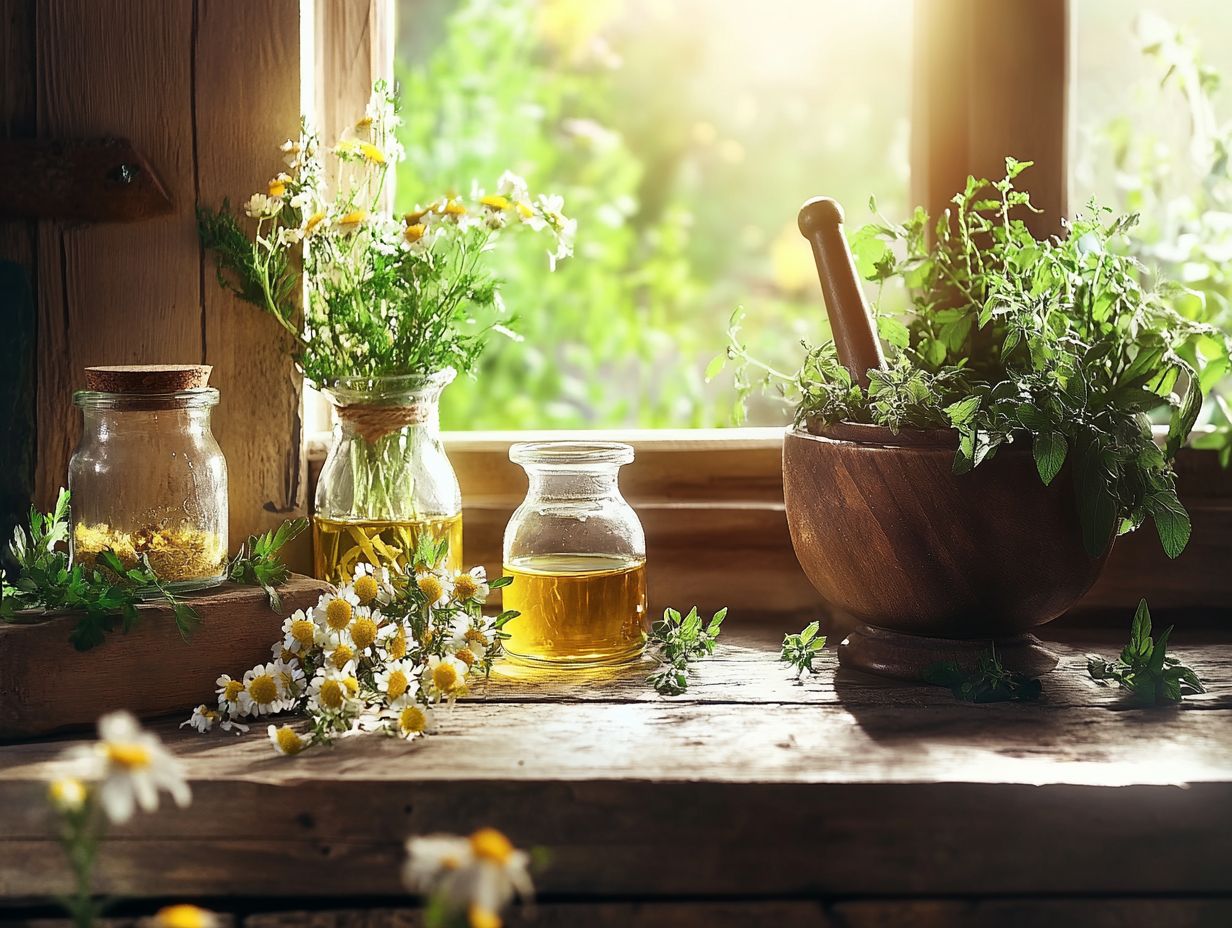
Proper storage techniques are crucial for preserving the strength and usefulness of herbal salves. These techniques help keep their healing properties intact, allowing you to enjoy the benefits they offer.
Proper Storage Techniques
Use containers that provide a moisture barrier and shield against light exposure. This will greatly preserve the healing properties of your salves.
Selecting the right containers can influence the longevity of your salves. Opt for glass jars with airtight seals, tinted amber or cobalt bottles, or BPA-free plastic tubes. These choices ensure a tight seal and protect your salve from contaminants.
Steer clear of metal containers; they can react with ingredients and compromise effectiveness. Regularly check the salve s consistency, smell, and color. Any changes could signal spoilage or loss of strength.
Recommended Uses and Dosages
Uses and dosages for herbal salves depend on the specific healing benefits of the herbs you choose, such as yarrow or lavender. Conduct a patch test before applying to larger areas to check for any adverse reactions.
This simple step helps you determine if your skin might react negatively to ingredients, especially if you have sensitivities or allergies.
Homemade salves and herbal oils can help with many common conditions, including:
- Dry skin herbal remedies can be effective.
- Minor cuts and scrapes, treated with herbal salves.
- Insect bites
- Muscle soreness
Apply a small amount directly to the affected area, reapplying as needed up to three times a day. Always consult a healthcare professional or herbalist to get the right dosage for you.
Keep track of any reactions during your patch test. This will guide your future applications effectively, especially when using medicinal herbs for topical treatments.
Frequently Asked Questions
What are homemade herbal salves?
Homemade herbal salves are skin-care products made from natural ingredients like beeswax, coconut oil, and olive oil, combined with various medicinal plants. They help soothe and heal skin conditions.
What are the benefits of using homemade herbal salves?
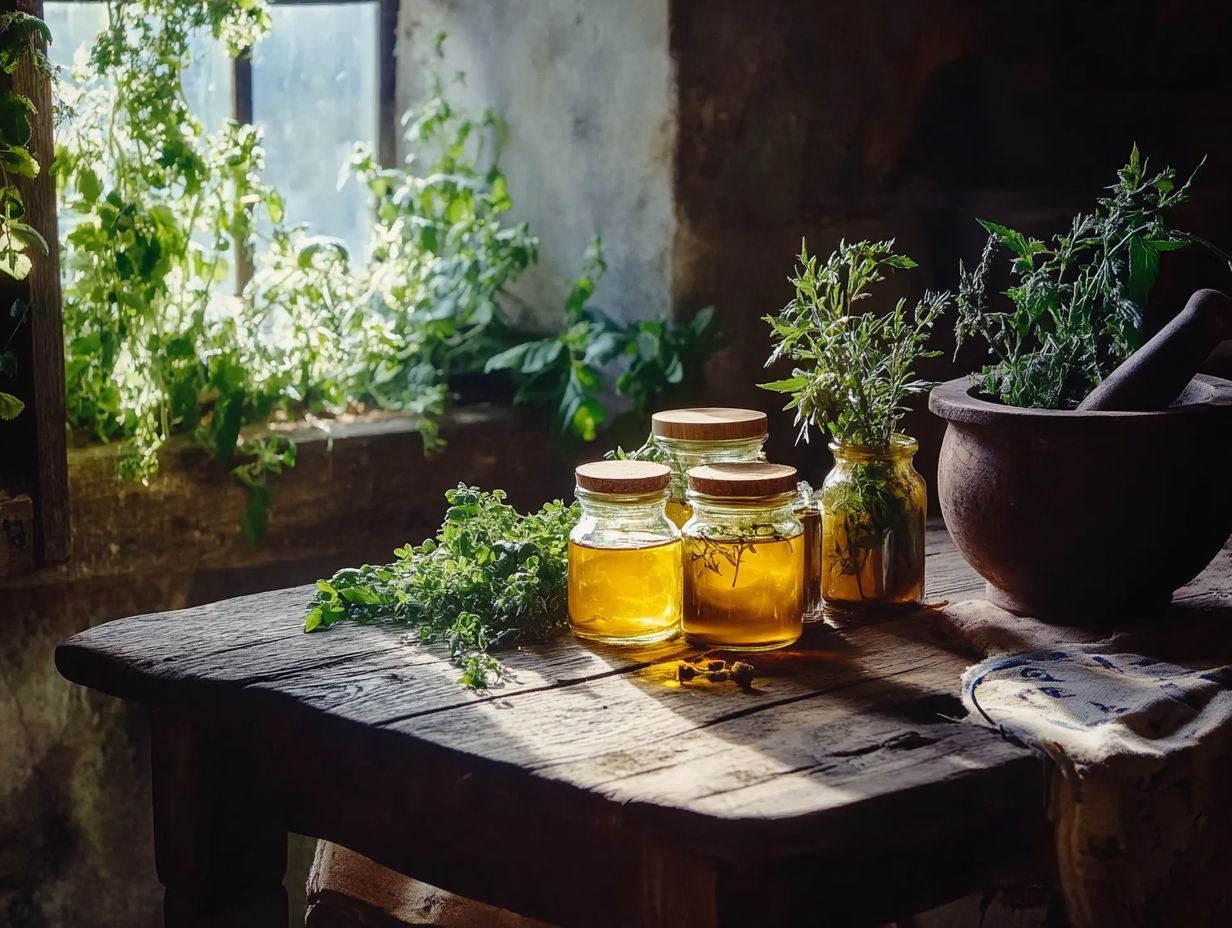
These salves are free of harmful chemicals and can be tailored to your needs. They are often more cost-effective than store-bought options and provide natural healing properties.
What ingredients are commonly used in homemade herbal salves?
Common ingredients include beeswax, carrier oils (like olive or coconut oil), and various herbs and essential oils. Shea butter and vitamin E oil may also be added for extra benefits.
Is it hard to make homemade herbal salves?
No, making them is easy with a few simple ingredients and tools. Many recipes can be found online, and the process usually involves heating and mixing the ingredients before pouring into containers to cool.
Are homemade herbal salves safe to use on all skin types, including sensitive skin?
Yes, homemade herbal salves are generally safe for all skin types, including sensitive skin. However, it is always recommended to do a patch test. This means applying a small amount to your skin to check for any bad reactions before using a new product, especially with herbal treatments.
What are some common uses for homemade herbal salves and DIY remedies?
Homemade herbal salves can be used for various purposes. They are great for moisturizing dry skin and soothing sunburns.
You can also use them to relieve insect bites and stings. They promote healing for cuts, scrapes, and bruises.
Additionally, you can use them for muscle and joint pain relief. Don’t miss out on these natural healing wonders!
They can even serve as a natural alternative to lip balm or hand cream. Try them today for instant relief!

